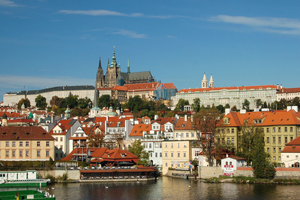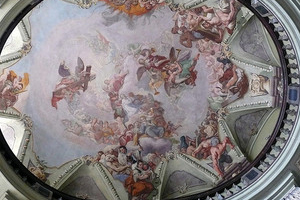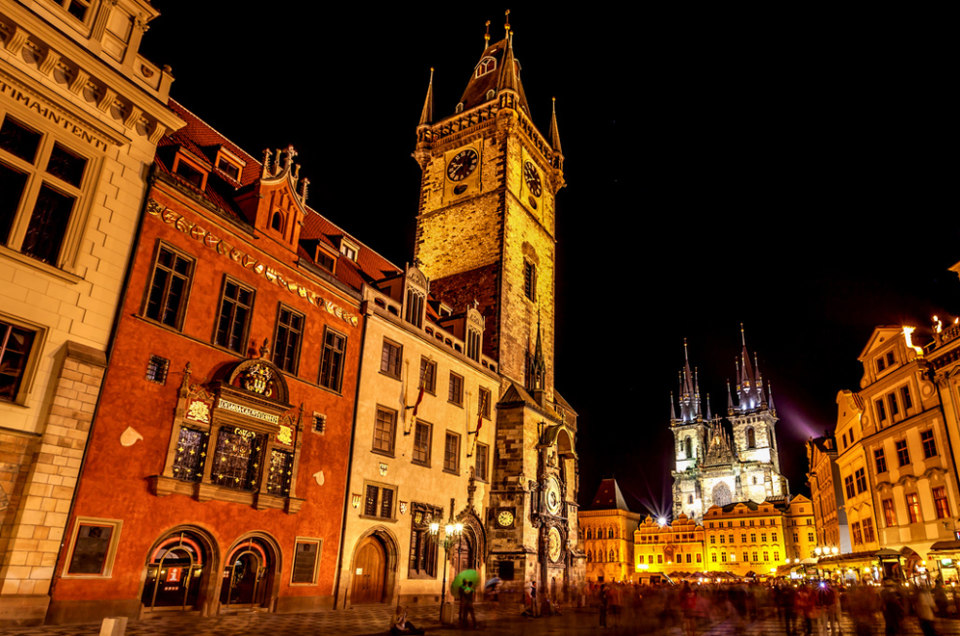Prague’s fairy tale spirit can still be found in its centuries-old cobbled streets and its castle perched on a hilltop, in its hidden alleys, its ancient bridges and dreamy spires. But take a closer look and you will find a city being reshaped by boutique hotels, innovative furniture, and edgy fashion.
My husband and I had been to Prague (separately) two decades ago and we were eager to rediscover together a city we once fell in love with. I recalled the decaying historic buildings in every possible shade of gray. Today they sport fresh coats of taupe, salmon, and azure. As the zigzagging streets got us closer to our hotel we found ourselves surrounded in a sea of cheerful pastels.
Despite undergoing intensive renovation and reconstruction Prague still has a certain air of being suspended in time (especially if you ignore the Burger Kings and McDonalds that are popping up everywhere). The crux of Prague is marked by an ancient cast of warlords and mystical rabbis, religious fanatics, and people of many different races. In the past thousand years, dark empires were created by tyrants who ruled the city, while emperors chose it as the place for thrones, encouraging architects and artists to create a city of astonishing edifices, ideas and images.
After the Velvet Revolution of 1989 dramatic changes occurred almost overnight. Decades of communist gloom behind them, a new generation of architects, artists and designers are thriving, their ideas and images redefining Prague.
Established in 1257, Mala Strana was for years home to the merchants and craftsmen who served the royal court. Today the Lesser Quarter, with its tiny lanes that end in wondrous courtyards and gardens, and its astonishing views of the Church of St. Nicholas surrounded by slopping red roofs, is jam-packed with tourists. The sights and textures, the sounds and the smells of the city are more intense than we remembered them 20 years ago, certainly more intense than they were in Communist times. Like the first filmmakers who experimented with capturing the color of real life on film, Prague and its residents are shedding their drab communist cloaks and living it up, Technicolor style.
These new hues and tints are spreading to Czech cooking as well. Customary dishes like potato soups, roasted pork, and dumplings can still be found at traditional pubs (hospody or pivnice). But Prague’s chefs at chic restaurants are creating high-end culinary delights. The quarter’s iconic restaurant is Square Malostranská kavárna (Malostranske namesti 5, Prague 1), which has long been a significant café in the city. It was founded in 1874 under the name Café Radetzky, and changed to Malostranská kavárna with the arrival of the First Republic in 1918. Czech writers Jan Neruda and Franz Kafka were among the café’s famous regulars. It is said that painter Jan Zrzav occasionally worked on his paintings inside the café. Today, Square attracts a distinguished clientele, and even celebs like Penelope Cruz make dinner reservations whenever they’re in town. And it’s no surprise: the poached halibut with sautéed vegetables, porcini foam, and enoki mushrooms are to die for, as are most of their dishes. Though the air is nippy, clusters of locals and tourists choose to sit at the pretty outdoor tables, while wispy clouds tickle the cerulean sky above.
On the short walk toward the famous Charles Bridge, a potpourri of languages echo effortlessly between the Mala Strana bridge towers, one Gothic, the other Romanesque. Here, street musicians, painters and artisans vie for attention while the legendary Baroque saint statues look warily as the hordes of tourists snap their pictures. On the other side of the Vltava river is Stare Mesto(Old Town). The quarter is the heart of the city and, like the colorful concoctions prepared at many of its newer bars, it’s bursting with a medley of styles: dark Gothic towers, Renaissance houses, Roman cellars, and dynamic Baroque façades. At Old Town Hall hundreds of people are gathering to see the hour struck by the mechanical figures of the Astronomical Clock. Just before the hour a skeleton tolls the death knell and turns an hourglass upside down; for their part the twelve Apostles parade around until a cockerel flaps its wings and crows, piercing the chilly air below while everyone awaits the hour to strike. Then it does, and hundreds of people look anxiously around, maybe with the knowledge that they just turned an hour older. The square clears and is suddenly silent, if only for a minute, before the next group of tourists arrives to watch time move forward.
We make our way to Kinsky Palace, which with its numerous statues and pink overlay, suggests a playful mood of its own while defying the new and modern buildings in the area. The palace is considered to be the city’s finest late-Baroque structures. It once housed a German school where Franz Kafka was a student for a short time, and now contains the National Gallery’s graphics collection. A block north is a boutique called Klara Nademlynska, Dlouhá 3, Prague 1), one of the most famous and successful Czech fashion designers. Intrigued by Cubist Czech architecture, we head to the House of the Black Madonna, a Cubist building which looks decidedly odd on Celetna Ulice, a street where the other buildings’ facades point to the 17th and 18th century. It was in the 1910s when intrepid young Czech architects employed Cubism’s radical reworking of visual space to structures. The House now accommodates a permanent exhibit of Czech Cubist design and hosts temporary art shows.
The best way to escape the throngs of sightseers is to get lost in the maze of tiny streets and winding alleys. Thibault and I do just that and quickly find ourselves at the door of Nostress Café, Dusni 10, Prague 1). The restaurant/gallery on this quiet street has served celebrities like Joseph Fiennes, Maggie Smith and Robert Carlyle. On our previous trips to Prague, we found the wait staff to be resolutely indifferent about taking food orders and bringing the dishes out before they got cold. However, the dining experience this time around proves that a lot more than just design has been redefined in Prague. At Nostress even the owner takes an interest in our visit and offers advice on places to visit. Downstairs the café hosts a gallery that features Czech ceramics, collages and paintings by local artists, as well as furniture from the 1930s.
The ideal time to walk around Josefov, the site of one of Europe’s most important Jewish communities, is on a moody, gray day. As if on cue, a thick mist begins to envelop the streets when we arrive, a provides a melancholic atmosphere that befits its olden times. The maze of courtyards and heaving alleyways that were once part of a labyrinthine old ghetto have been replaced by wide avenues and boulevards. Josefov, with its six synagogues, the Jewish Town Hall and the Old Jewish Cemetery, is now one of the most popular tourist neighborhoods in Prague.
After dark the city of a hundred spires takes on a whole new attitude. A full moon plays peek-a-boo from behind ethereal clouds while the stunningly lit towers of the Church of the Virgin Mary rise eerily over the lustrous baroque facades. Soon the crowds thin out and the phantoms of the square’s turbulent past return. (In 1419 the first of Prague’s many famous defenestrations occurred when Catholic consuls and German citizens were thrown out the window of the town hall by rioting Hussites.) While the streets remain deathly still, whiffs of smoke, laughter and conversation spill out from every hospody. On this night we skip the pubs and head to Nove Mesto (New Town) an area whose lively streets lined with Gothic churches and squares were planned by Charles IV back in 1348. The outer fringes of Old and New Town are interspersed with modernist architecture. It’s in this section of town that architect Josef Chochol designed many of the city’s amazing Cubist projects: his masterpiece and own apartment is a pyramidal building at Neklanova 30; at Neklanova 2 is another one that uses the same type of shapes with hints of Gothic columns.
Not far is Jazz Café Cislo 14 (Opatovicka 14), where the walls are lined with small paintings by local artists. In the 1930s this was the spot to get your discussion on, and where on certain nights local artist Jan Zrzavy could be spotted in the crowd. Even now young bohemians can be heard discussing the merits of love, literature, and drugs in between sips of absinthe. The scene is decidedly different at Velryba, (Opatovicka 24), which has the distinction of being the first gallery-café to open its doors in 1989. Behind the wood bar, hanging in between the bottles of vodka and whisky, is a rounded mirror where you can subtly spy on the barflies. After one too many glasses of Czech wine we call it a night.
In Prague, the paradoxical nature of its people is reflected in the city’s architecture, music and literature. Described as a “metaphysical madhouse,” Prague’s multi-layered culture has been shaped by years of victory and defeat. Its rhythms encompass radiant optimism and gloom, dark humor sprinkled with gentle irony. Its people are at once highly romantic yet they maintain a certain degree of skepticism – they’re as likely to scoff at you as to invite you in for a pint of Pilsner. This duality is found everywhere but nowhere is it more clear than in its impassioned streets.
Walking back to our hotel we realize that the Prague that we visited over a decade ago is long gone. In the Prague of the 21st century the cuisine has been refined, fashion has been altered, and even the city’s palette has changed.



